Nahargarh Fort
| Built In: | 1734 AD |
| Built By: | Maharaja Sawai Jai Singh II |
| Renovated By: | Sawai Ram Singh in 1868 |
| Managed By: | Government of Rajasthan |
| Visiting Hours: | 10 AM to 5 PM, everyday |
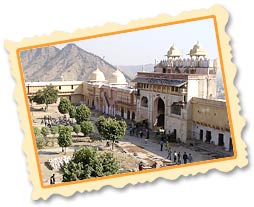 The
Indian state of Rajasthan is famous for its royal heritage. Formed by
the union of many princely states ruled mainly by Rajputs, Rajasthan has
many forts and palaces. Some of these palaces and forts are associated
with important historical events as well. Nahargarh Fort, along with
other two forts viz., Amer Fort and Jaigarh Fort, once formed a strong
defense for Jaipur city. Built by Maharaja Sawai Jai Singh II in 1734,
this fort was originally named Sudarshangarh Fort. Later, it was given a
new name, Nahargarh which means 'abode of tigers'. Located in one of
the oldest mountain ranges of the world, the Aravalli Hills, this fort
gives you a breathtaking view of the scenic surroundings. One of the
major tourist attractions of Jaipur, Nahargarh Fort is noted for its
extended wall which connects it to the Jaigarh Fort.
The
Indian state of Rajasthan is famous for its royal heritage. Formed by
the union of many princely states ruled mainly by Rajputs, Rajasthan has
many forts and palaces. Some of these palaces and forts are associated
with important historical events as well. Nahargarh Fort, along with
other two forts viz., Amer Fort and Jaigarh Fort, once formed a strong
defense for Jaipur city. Built by Maharaja Sawai Jai Singh II in 1734,
this fort was originally named Sudarshangarh Fort. Later, it was given a
new name, Nahargarh which means 'abode of tigers'. Located in one of
the oldest mountain ranges of the world, the Aravalli Hills, this fort
gives you a breathtaking view of the scenic surroundings. One of the
major tourist attractions of Jaipur, Nahargarh Fort is noted for its
extended wall which connects it to the Jaigarh Fort.History Of The Fort
Nahargarh Fort was built in 1734 by Maharaja Sawai Jai Singh II, founder of Jaipur, on the Aravalli hills, as a retreat place. Nahargarh Fort is connected to the Jaigarh Fort through its fortifications. It is believed that the construction of this fort was obstructed by the spirit of a Rathore prince, Nahar Singh Bhomia. However, the spirit was pacified when a temple dedicated to him was built inside the fort. Sawai Ram Singh renovated this fort in 1868.
Architectural Layout Of The Fort
The fort follows Indo-European architecture and there are many structures inside the fort. To the left of the entrance gate 'Tadigate', there is a temple dedicated to the deity of Jaipur rulers. Apart from this, there is another temple inside the fort, dedicated to the Rathore prince, Nahar Singh Bhomia. Another attraction in the fort is the 'Madhavendra Bhawan' built by Sawai Madho Singh. This is a two-storey building which has suites for the king and his twelve queens. It is divided into nine similar apartments and each of these apartments has a lobby, bedrooms, toilets, kitchen and store. Other structures inside the palace include Diwan-I-Aam, an open air enclosure where the king met the common men and listened to their problems and complaints.
Important Battles
Nahargarh Fort was never attacked but, it witnessed some major historical events, like the treaties with the Maratha forces which attacked Jaipur in the 18th century. This fort gave shelter to many Europeans in this region, including the British Resident's wife, during the Sepoy Mutiny of 1857.
Nearby Tourist Attractions
Located 2.7km away from the fort, Jantar Mantar is one of the five astronomical observatories in western central India. Other places worth visiting nearby are the City Palace, Hawa Mahal, Jalmahal, Jaigarh Fort and Amer Fort. Located in a scenic backdrop of the Aravalli Hills, Nahargarh Fort offers a breathtaking view of the hilly milieu. The wonderful trek from the foot of the hill to the top, where the fort is located, is truly a great experience.
Amer Fort
| Location: | Jaipur, Rajasthan |
| Built by: | Raja Man Singh |
| Built in: | 1592 AD |
| Renovated By: | Jai Singh I |
| Visiting Hours: | 9:30 AM - 4:30 PM everyday (except on Holi) |
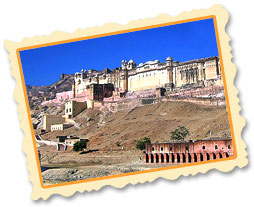 The Amer Fort, situated in Amber, 11 kilometers from Jaipur, is one of the most famous forts of Rajasthan.
Amer, originally, was the capital of the state before Jaipur. It is an
old fort, built in 1592 by Raja Man Singh. This fort is also very
popularly known as the Amer Palace. The Amer Fort was built in red
sandstone and marble and the Maotha Lake adds a certain charm to the
entire Fort. Though the fort is quite old and may even look so from the
outside, it is beautiful on the inside and boasts of various buildings
of prominence like the 'Diwan-i-Aam', the 'Sheesh Mahal' and even the
'Sukh Mahal'. The Amer Fort has influences of both Hindu and Muslim
architecture. This fort also has the 'Shila Devi' Temple and the 'Ganesh
Pol' which is a gate that leads to the private palaces of the kings.
The Amer Fort has many pavilions and halls of great interest and other
popular attractions.
The Amer Fort, situated in Amber, 11 kilometers from Jaipur, is one of the most famous forts of Rajasthan.
Amer, originally, was the capital of the state before Jaipur. It is an
old fort, built in 1592 by Raja Man Singh. This fort is also very
popularly known as the Amer Palace. The Amer Fort was built in red
sandstone and marble and the Maotha Lake adds a certain charm to the
entire Fort. Though the fort is quite old and may even look so from the
outside, it is beautiful on the inside and boasts of various buildings
of prominence like the 'Diwan-i-Aam', the 'Sheesh Mahal' and even the
'Sukh Mahal'. The Amer Fort has influences of both Hindu and Muslim
architecture. This fort also has the 'Shila Devi' Temple and the 'Ganesh
Pol' which is a gate that leads to the private palaces of the kings.
The Amer Fort has many pavilions and halls of great interest and other
popular attractions.History Of The Fort
Amer was once known as Dhundar and was ruled by the Kachhwahas from the 11th to the 16th century, until the capital was moved from here to Jaipur. Raja Man Singh built this fort in 1592 AD and Raja Jai Sigh I expanded and renovated it later. While many such old structures have been either destroyed or replaced by other things, this fort has stood against all the tests of time and invasions.
Architectural Layout
The structure has four different parts, each with a separate entrance. The main entry to the fort is through the 'Suraj Pol' or Sun Gate which opens up into the main courtyard. This east-facing gate is also the main entrance to the palace and its position with respect to the rising sun is the source of its name. The 'Jaleb Chowk' is one of the four courtyards of the Amer Palace. The 'Sila Devi' Temple is right at the entrance to the main palace grounds. The second courtyard is famous for its 'Diwan-i-Aam' (Public Audience Hall), the 'Sheesh Mahal' and the 'Sukh Mahal'. A very famous attraction here is the 'Magic Flower', a fresco carved out of marble.
Nearby Tourist Attractions
- Jaigarh Fort
- Aravalli Hills
- Vijay Garh
The Amer Fort/Palace is a beautiful structure that was
built by Raja Man Sing in the 16th century. Don't forget to check out
the 'Sheesh Mahal', 'Diwan-i-Aam' and 'Sukh Mahal' also. The fort is a
ten minute walk uphill and your little trek will be worth the wonders
that it offers. Don't miss the royal elephant ride while you are at it!
City Palace, Jaipur
| Built In: | 1729-1732 AD |
| Built By: | Sawai Jai Singh |
| Visiting Hours: | 10:00 AM to 5:00 PMeveryday (except on Holi, Diwali and National Holidays) |
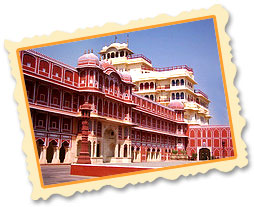 Located
in the heart of the Pink City Jaipur, the City Palace was where the
Maharaja reigned from. This palace also includes the famous 'Chandra
Mahal' and 'Mubarak Mahal', and other buildings which form a part of the
palace complex. The palace is located towards the northeast side of
central Jaipur and has many courtyards and buildings. The palace was
built between 1729 and 1732 AD by Sawai Jai Singh II. He ruled in Amer
and planned and built the outer walls of the palace and later rulers
added to the architecture of this palace. These additions have been
known to take place right up to the 20th century. The urban layout of
the city of Jaipur was commissioned to Vidyadhar Bhattacharya and Sir
Samuel Swinton Jacob. The architectural styles are largely based on a
fusion of Rajput, Mughal and European styles. Today, the 'Chandra Mahal'
has been turned into a museum which is home to unique handcrafted
products, various uniforms of the rulers and many more things pertaining
to the royal heritage of the City Palace.
Located
in the heart of the Pink City Jaipur, the City Palace was where the
Maharaja reigned from. This palace also includes the famous 'Chandra
Mahal' and 'Mubarak Mahal', and other buildings which form a part of the
palace complex. The palace is located towards the northeast side of
central Jaipur and has many courtyards and buildings. The palace was
built between 1729 and 1732 AD by Sawai Jai Singh II. He ruled in Amer
and planned and built the outer walls of the palace and later rulers
added to the architecture of this palace. These additions have been
known to take place right up to the 20th century. The urban layout of
the city of Jaipur was commissioned to Vidyadhar Bhattacharya and Sir
Samuel Swinton Jacob. The architectural styles are largely based on a
fusion of Rajput, Mughal and European styles. Today, the 'Chandra Mahal'
has been turned into a museum which is home to unique handcrafted
products, various uniforms of the rulers and many more things pertaining
to the royal heritage of the City Palace.History Of City Palace
Maharaja Sawai Jai Singh II is known to have commissioned work for building the outer wall of the city's complex. He shifted from Amer to Jaipur due to water problems and an increase in population in 1727. He had entrusted the city's architectural design to the chief architect Vidyadhar Bhattacharya. The architect went on to design the City Palace in accordance with the Vaastushastra texts.
Architectural Layout
The City Palace reflects Rajput, Mughal and European architectural styles although the palace was designed to Vaastushastra treatise. Some of the famous gates are the 'Udai Pol', 'Jaleb Chowk', 'Tripolia Gate' and 'Virendra Pol', which also happen to be the various entrances to the palace. These are all richly decorated. The Palace has been designed according to a 'grid style' and houses various structures such as, 'Chandra Mahal', 'Mubarak Mahal', 'Diwan-I-Khas' and the 'Govind Dev Ji Temple. The walls and gates are ornately designed to Mughal style, with various murals, lattice and mirrors adorning them from sides.
Nearby Tourist Attractions
- Hawa Mahal
- Jal Mahal
- Government Central Museum
- Jantar Mantar
- Vidhyadhar's Garden
The City Palace is a landmark in Jaipur and is also a
very popular tourist hotspot. Apart from the regal architecture, the
palace offers a stunning view of the Pink City and also an insight into
the rich heritage of a bygone era. The City Palace is a must-see while
sightseeing in Jaipur.
Gaitore
| Location: | 15 kilometers from Jaipur, towards Amer |
| Highlights: | Cenotaphs with typical Rajasthani Carvings |
| Visiting Hours: | 10:00 AM to 5:30 PM every day except Sundays |
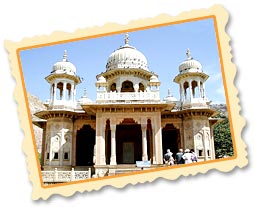 How to Reach:
Gaitore has excellent road connectivity as the place is located on the
Jaipur-Amer road which is 15 km away from the city. People can also hire
autos, taxis or local buses which ply frequently from the city to the
monument.
How to Reach:
Gaitore has excellent road connectivity as the place is located on the
Jaipur-Amer road which is 15 km away from the city. People can also hire
autos, taxis or local buses which ply frequently from the city to the
monument.Gaitore, one of the most prominent tourist attractions in Jaipur, is a royal cremation ground for the Kachhwaha Rajput kings and the members of the royal family. The word 'Gaitore' is believed to be a mispronounced form of the Hindi phrase, 'Gaye ka Thor' which means 'resting place of the departed souls'. Located on a narrow valley on Jaipur-Amer road, this place is 15 km away from Jaipur. The valley has cenotaphs (chhatri) made of marble and sandstone with Rajastani carvings, dedicated to legendary kings who ruled Jaipur. A perfect blending of Islamic and Hindu temple architecture, Gaitore has cenotaphs of Sawai Ram Singh, Sawai Madho Singh and Maharaja Sawai Jai Singh II and so on. Among these kings, the cenotaph of Maharaja Sawai Jai Singh II is quite impressive with its intricate peacock carvings and designs on beautiful white marble structure. It is said that the carvings on each cenotaph reflects the taste of the respective king. Read further to know more about Gaitore and its historic significance.
History
Gaitore, the royal cremation ground of the Kachhwaha Rajputs, was chosen as the designated place by Maharaja Sawai Jai Singh II, the founder of Jaipur, after he shifted the capital to the city. From 1733, the cremation of every Kachhwaha king was done here. The only cenotaph which is missing from here is the one of Maharaja Sawai Ishwari Singh whose cremation was done in the city palace complex in Jaipur.
Architecture
The cenotaphs of Gaitore symbolise the perfect blending of Islamic architecture and Hindu temple architecture. These are open domed pavilions which are built on a raised platform. Among the various cenotaphs dedicated to Sawai Ram Singh, Sawai Madho Singh and Maharaja Sawai Jai Singh II, the one which is dedicated to Maharaja Sawai Jai Singh II stands out. This cenotaph, made of pure white marble, is decorated with stunning peacock deigns and patterns. The carvings in each cenotaph reflect the style and taste of the specific king and the culture which was prevalent in his time. Traces of paintings which once decorated the walls of the cenotaphs can still be seen.
Nearby Tourist Attractions
There are plenty of tourist attractions near Gaitore which include City Palace, Govindji Temple, Jantar Mantar, Hawa Hahal, Nahargarh Fort, Jal Mahal, Moti Doongari and Lakshmi Narayan Temple and so on.
Gaitore, the final resting place of the Kachhwaha Rajput monarchs, takes us back to the splendid royal heritage of the kings of Jaipur. Its cenotaphs are a perfect blend of Hindu temple and Islamic architecture and have attracted the attention of Indian as well as foreign tourists.
Hawa Mahal
| Location: | Jaipur, Rajastan |
| Built by: | Maharaja Sawai Pratap Singh |
| Built in: | 1799 AD |
| Visiting Hours: | 9:00 AM to 4:00 PM(Daily) |
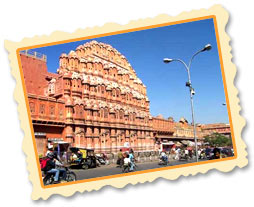 The
renowned 'Palace Of The Winds', or Hawa Mahal, is one of the prominent
tourist attractions in Jaipur city. Located in the heart of Jaipur, this
beautiful five-storey palace was constructed in 1799 by Maharaja Sawai
Pratap Singh who belonged to Kachhwaha Rajput dynasty. The main
architect of this palace built of red and pink sandstone, is Lal Chand
Ustad and the palace is believed to have been constructed in the form of
the crown of Krishna, the Hindu god. Considered as an embodiment of
Rajputana architecture, the main highlight of Hawa Mahal is its pyramid
shape and its 953 windows or 'Jharokhas' which are decorated with
intricate designs. The main intention behind the construction of the
Mahal was to facilitate the royal women and provide them a view of
everyday life through the windows, as they never appeared in public.
Read further to know more about Hawa Mahal, its history, architecture
and its visiting hours.
The
renowned 'Palace Of The Winds', or Hawa Mahal, is one of the prominent
tourist attractions in Jaipur city. Located in the heart of Jaipur, this
beautiful five-storey palace was constructed in 1799 by Maharaja Sawai
Pratap Singh who belonged to Kachhwaha Rajput dynasty. The main
architect of this palace built of red and pink sandstone, is Lal Chand
Ustad and the palace is believed to have been constructed in the form of
the crown of Krishna, the Hindu god. Considered as an embodiment of
Rajputana architecture, the main highlight of Hawa Mahal is its pyramid
shape and its 953 windows or 'Jharokhas' which are decorated with
intricate designs. The main intention behind the construction of the
Mahal was to facilitate the royal women and provide them a view of
everyday life through the windows, as they never appeared in public.
Read further to know more about Hawa Mahal, its history, architecture
and its visiting hours.History
It was in 1799 that the Kachhwaha Rajput ruler, Sawai Pratap Singh, grandson of Maharaja Sawai Jai Singh who built Jaipur, constructed Hawa Mahal as a continuation of the Royal City Palace. Sawai Pratap Singh's devotion to Lord Krishna is evident in the palace's construction as it resembles the lord's crown. Though many reasons are cited behind the construction of the fort, Purdah system followed by the Rajputs is said to be one of the main causes. During those days, Rajput royal women did not appear in public or in front of strangers. However, they were keen to follow the day-to-day events and royal processions occurring on the streets. It is for their benefit that the Hawa Mahal was built, complete with small windows and screened balconies. This gave the women a sense of freedom, without appearing in public.
Architecture
Hawa Mahal, designed as a beehive castle with small windows, has a height of 50 feet from its base. This structure, erected on a thin shield or podium approximately fifty feet high, has walls less than a foot thick. Constructed of red and pink sandstones by Lal Chand Ustad, Hawa Mahal is famous for its windows or 'Jharokhas' which enable free circulation of air within the structure. Its entrance is a door which leads to a spacious courtyard surrounded by two-storey buildings on three sides. Of the five storeys of the Mahal, the top three storeys have the thickness of a single room while the bottom storeys have courtyards. The interior of the Hawa Mahal is stark and plain with passages and pillars reaching to the top storey. The building does not have stairs to reach the upper floors; the storeys are connected by slopes. From Hawa Mahal, you have an excellent view of the city. The monument also has an archeological museum.
Nearby Tourist Attractions
There are numerous attractions around Hawa Mahal such as the famed Jantar Mantar, Govind Devji temple, Amer Fort, Nahargarh Fort, Ram Niwas Bagh, BM Birla Planetarium, Jain Temple, Statue Circle, Sisodia Rani Garden and so on.
Hawa Mahal, which is the quintessence of Rajput architecture, stands high in the heart of Jaipur city as a prominent attraction. Hope this article familiarizes you with Hawa Mahal and its historic significance.
Jaigarh Fort
| Location: | Jaipur, Rajasthan |
| Built in: | 1726 AD |
| Built By: | Sawan Jai Singh II |
| Visiting Hours: | 9:00 am -5:00 pm |
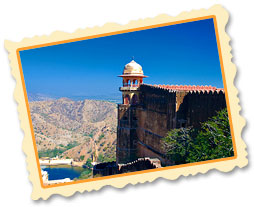 The
Jaigarh Fort is a majestic stronghold built by Sawan Jai Singh II. This
almost-intact fort is surrounded by huge battlements and is connected
to the Amer Fort (also called 'Amber' Fort), with subterranean passages.
Originally built to protect the Amer Fort and the palace within the
complex, the Jaigarh Fort is architecturally similar to the Amer Fort,
and offers a panoramic view of the city of Jaipur. The fort houses the
world's largest cannon on wheels, a majestic palace complex and the
assembly hall of the warriors known as 'Shubhat Niwas' along with a
museum and an armory. Apart from the intricate architecture of the fort,
the fort was also renowned for a huge treasure that was believed to be
buried under the fort. It is now said that the government of Rajasthan
seized the treasure when it was discovered in the 1970s. The Jaigarh
Fort was built to secure Jaipur City and the Amer fort from warlords and
rivals.
The
Jaigarh Fort is a majestic stronghold built by Sawan Jai Singh II. This
almost-intact fort is surrounded by huge battlements and is connected
to the Amer Fort (also called 'Amber' Fort), with subterranean passages.
Originally built to protect the Amer Fort and the palace within the
complex, the Jaigarh Fort is architecturally similar to the Amer Fort,
and offers a panoramic view of the city of Jaipur. The fort houses the
world's largest cannon on wheels, a majestic palace complex and the
assembly hall of the warriors known as 'Shubhat Niwas' along with a
museum and an armory. Apart from the intricate architecture of the fort,
the fort was also renowned for a huge treasure that was believed to be
buried under the fort. It is now said that the government of Rajasthan
seized the treasure when it was discovered in the 1970s. The Jaigarh
Fort was built to secure Jaipur City and the Amer fort from warlords and
rivals.History Of The Fort
- The Jaigarh Fort is an opulent structure built in the early 18th century. Amer, the city in which the Jaigarh and the Amer fort are located, was ruled by the Kachawahas from the early 10th century.
- During the Mughal dynasty, the Jaigarh Fort became their empire's main cannon foundry and was also used as storage stronghold to store ammunition and other metal required for war.
- During the successive wars that broke out in the Mughal dynasty in 1658, the cannon outpost at the Jaigarh fort was protected until the protector, Dara Shikoh, was defeated and executed by his own brother, Aurangzeb.
- Later, the fort was handed over to Jai Singh II and he is known to have molded the great ‘Jaivana Cannon', along with using the devices and the foundries inside the fort.
Architecture
The fort is built with thick walls of red sandstone and is spread over a vast range of 3 kilometers in length, with a width of one kilometer. The fort houses the world's greatest cannon on wheels known as the 'Jaivana Cannon' and a huge palace complex. This includes the Laxmi Vilas, Lalit Mandir, Aram Mandir and the Vilas Mandir. The fort has a well-tended garden which can be viewed by tourists even today along with an armory and a museum.
Important Battles
The Jaigarh fort was never conquered in battle, and was also the strongest of the three forts in Jaipur. During the Mughal dynasty, the fort bore witness to an ambush by Aurangzeb who defeated and killed his own brother who was the overseer of the cannon outpost in the fort. Apart from that, the fort never witnessed any major resistance, and only test-fired the world's largest cannon, once!
Nearby Tourist Attractions
The fort is built with thick walls of red sandstone and is spread over a vast range of 3 kilometers in length, with a width of one kilometer. The fort houses the world's greatest cannon on wheels known as the 'Jaivana Cannon' and a huge palace complex. This includes the Laxmi Vilas, Lalit Mandir, Aram Mandir and the Vilas Mandir. The fort has a well-tended garden which can be viewed by tourists even today along with an armory and a museum.
Important Battles
The Jaigarh fort was never conquered in battle, and was also the strongest of the three forts in Jaipur. During the Mughal dynasty, the fort bore witness to an ambush by Aurangzeb who defeated and killed his own brother who was the overseer of the cannon outpost in the fort. Apart from that, the fort never witnessed any major resistance, and only test-fired the world's largest cannon, once!
Nearby Tourist Attractions
- Amer Fort
- Vijay Garh
- Aravalli hills
The Jaigarh Fort is a palatial structure perched on
the 'Cheel ka teela' hills, much like a jewel on a crown. Designed by a
talented architect called Vidhyadhar, the fort is a regal reminder of
the city's affluent history and is named after Jai Singh II, the ruler
who got it built.
Jantar Mantar Jaipur
| Built In: | 1728-1734 |
| Built By: | Maharaja Jai Singh II |
| Renovated By: | Major Arthur Garrett |
| Highlight: | Listed on UNESCO World Heritage List |
| Managed By: | Government of Rajasthan |
| Visiting Hours: | 9:00 AM to 4:30 PM everyday |
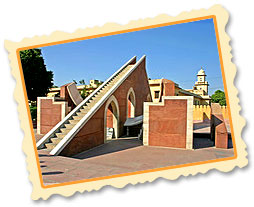 There
are plenty of observatories all over the world, but the Jantar Mantar
is considered to be one of the largest observatories ever built.
Combining religion, science and art, the Jantar Mantar is the name given
to a series of five, magnificent structures built in Jaipur, New Delhi,
Ujjan, Varanasi and Mathura. Jaipur was the seat of Maharaja Jai Singh
II during the 1720's and this is when this magnificent structure was
built here. The Jantar Mantar in Jaipur is considered to be the largest
of the five observatories and also houses the world's largest sundial.
The Universe and the Cosmos have always been of interest to man, and it
was this interest that compelled the Maharaja to build an astronomical
observatory. The term 'Jantar Mantar' is derived from the Sanskrit terms
'Yantra' and 'Mantra' meaning 'instruments' and 'formula' respectively.
The term 'Yantra' was replaced with 'Jantar' which means 'magical'. The
Jantar Mantar houses various architectural and astrological instruments
that have caught the interests of astronomers, historians and
architects around the world.
There
are plenty of observatories all over the world, but the Jantar Mantar
is considered to be one of the largest observatories ever built.
Combining religion, science and art, the Jantar Mantar is the name given
to a series of five, magnificent structures built in Jaipur, New Delhi,
Ujjan, Varanasi and Mathura. Jaipur was the seat of Maharaja Jai Singh
II during the 1720's and this is when this magnificent structure was
built here. The Jantar Mantar in Jaipur is considered to be the largest
of the five observatories and also houses the world's largest sundial.
The Universe and the Cosmos have always been of interest to man, and it
was this interest that compelled the Maharaja to build an astronomical
observatory. The term 'Jantar Mantar' is derived from the Sanskrit terms
'Yantra' and 'Mantra' meaning 'instruments' and 'formula' respectively.
The term 'Yantra' was replaced with 'Jantar' which means 'magical'. The
Jantar Mantar houses various architectural and astrological instruments
that have caught the interests of astronomers, historians and
architects around the world.History
Maharaja Jai Singh II, the founder of the 'pink city', was a great scholar and an avid astrologer. He studied philosophy, astrology, architecture and religion in various schools, and was also well versed with universal mathematical concepts such as Euclid's Clements, Ptolemy's Syntaxes and the Master works of Aryabhatta. In the year 1718, he wanted to construct an observatory of renown. For this, he studied the subject of astronomy and then built five different observatories around North India. At these places, he would sit with other scholarly astronomers, such as Pt. Kedarnath, for astronomical observations. The 'Jantar Mantar' at Jaipur, being the biggest conservatory in the country, was renovated time and again and houses various instruments that offer precise measurements of time, the azimuth, declination of the sun and the positions of constellations, along with several other astronomical phenomena. The Jaipur observatory was functional for seven years only, as the Maharaja was not very successful in deriving accurate, astronomical observations.
Architecture
The astronomical observatory consists of fourteen major geometric devices for measuring time, tracking constellations and, even for, observing the orbits around the sun. Popular structures within the Jantar Mantar are the 'Samrat Yantra' (the world's largest sundial), the 'Hindu Chhatri', the 'Jaiprakash Yantra' and various geometric structures with astronomical devices to probe the 'universe'.
Nearby Tourist Attractions
- Jaipur City Palace
- Jaigarh Fort
- Galta Monkey Temple
The Jantar Mantar is a resplendent reminder of the
royal heritage of Jaipur and stands as a royal testimony to a former
epoch. The magnificent structure still manages to capture the attention
of tourists and astronomy enthusiasts alike! The Jantar Mantar is an
intriguing structure, and is a must-see in Jaipur!
Nahargarh Fort
| Built In: | 1734 AD |
| Built By: | Maharaja Sawai Jai Singh II |
| Renovated By: | Sawai Ram Singh in 1868 |
| Managed By: | Government of Rajasthan |
| Visiting Hours: | 10 AM to 5 PM, everyday |
 The
Indian state of Rajasthan is famous for its royal heritage. Formed by
the union of many princely states ruled mainly by Rajputs, Rajasthan has
many forts and palaces. Some of these palaces and forts are associated
with important historical events as well. Nahargarh Fort, along with
other two forts viz., Amer Fort and Jaigarh Fort, once formed a strong
defense for Jaipur city. Built by Maharaja Sawai Jai Singh II in 1734,
this fort was originally named Sudarshangarh Fort. Later, it was given a
new name, Nahargarh which means 'abode of tigers'. Located in one of
the oldest mountain ranges of the world, the Aravalli Hills, this fort
gives you a breathtaking view of the scenic surroundings. One of the
major tourist attractions of Jaipur, Nahargarh Fort is noted for its
extended wall which connects it to the Jaigarh Fort.
The
Indian state of Rajasthan is famous for its royal heritage. Formed by
the union of many princely states ruled mainly by Rajputs, Rajasthan has
many forts and palaces. Some of these palaces and forts are associated
with important historical events as well. Nahargarh Fort, along with
other two forts viz., Amer Fort and Jaigarh Fort, once formed a strong
defense for Jaipur city. Built by Maharaja Sawai Jai Singh II in 1734,
this fort was originally named Sudarshangarh Fort. Later, it was given a
new name, Nahargarh which means 'abode of tigers'. Located in one of
the oldest mountain ranges of the world, the Aravalli Hills, this fort
gives you a breathtaking view of the scenic surroundings. One of the
major tourist attractions of Jaipur, Nahargarh Fort is noted for its
extended wall which connects it to the Jaigarh Fort.History Of The Fort
Nahargarh Fort was built in 1734 by Maharaja Sawai Jai Singh II, founder of Jaipur, on the Aravalli hills, as a retreat place. Nahargarh Fort is connected to the Jaigarh Fort through its fortifications. It is believed that the construction of this fort was obstructed by the spirit of a Rathore prince, Nahar Singh Bhomia. However, the spirit was pacified when a temple dedicated to him was built inside the fort. Sawai Ram Singh renovated this fort in 1868.
Architectural Layout Of The Fort
The fort follows Indo-European architecture and there are many structures inside the fort. To the left of the entrance gate 'Tadigate', there is a temple dedicated to the deity of Jaipur rulers. Apart from this, there is another temple inside the fort, dedicated to the Rathore prince, Nahar Singh Bhomia. Another attraction in the fort is the 'Madhavendra Bhawan' built by Sawai Madho Singh. This is a two-storey building which has suites for the king and his twelve queens. It is divided into nine similar apartments and each of these apartments has a lobby, bedrooms, toilets, kitchen and store. Other structures inside the palace include Diwan-I-Aam, an open air enclosure where the king met the common men and listened to their problems and complaints.
Important Battles
Nahargarh Fort was never attacked but, it witnessed some major historical events, like the treaties with the Maratha forces which attacked Jaipur in the 18th century. This fort gave shelter to many Europeans in this region, including the British Resident's wife, during the Sepoy Mutiny of 1857.
Nearby Tourist Attractions
Located 2.7km away from the fort, Jantar Mantar is one of the five astronomical observatories in western central India. Other places worth visiting nearby are the City Palace, Hawa Mahal, Jalmahal, Jaigarh Fort and Amer Fort. Located in a scenic backdrop of the Aravalli Hills, Nahargarh Fort offers a breathtaking view of the hilly milieu. The wonderful trek from the foot of the hill to the top, where the fort is located, is truly a great experience.
Statue Circle
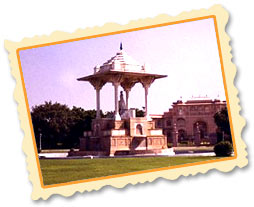 Jaipur
city offers a number of interesting tourist spots and one among them is
the famous Statue Circle. Located at a busy traffic junction, the
Statue Circle in Jaipur city has been a central place through which
almost half of the city's population passes while navigating through
this Pink City. Statue Circle is a popular hang-out spot in Jaipur and
the most famous circle known in the Pink City. The lovely ambience of
this famous circle offers a perfect place to hang around and enjoy the
pleasant breeze of the evening air. Its brilliant lightings and dazzling
fountains add up to the liveliness and vibrancy of the place. There are
numbers of rich local delicacies and spicy snacks which are served by
the vendors here. Besides being a famous tourist and picnic spot, the
Statue Circle also serves as a favorite place for evening walkers,
morning joggers, etc.
Jaipur
city offers a number of interesting tourist spots and one among them is
the famous Statue Circle. Located at a busy traffic junction, the
Statue Circle in Jaipur city has been a central place through which
almost half of the city's population passes while navigating through
this Pink City. Statue Circle is a popular hang-out spot in Jaipur and
the most famous circle known in the Pink City. The lovely ambience of
this famous circle offers a perfect place to hang around and enjoy the
pleasant breeze of the evening air. Its brilliant lightings and dazzling
fountains add up to the liveliness and vibrancy of the place. There are
numbers of rich local delicacies and spicy snacks which are served by
the vendors here. Besides being a famous tourist and picnic spot, the
Statue Circle also serves as a favorite place for evening walkers,
morning joggers, etc.History Of Statue Circle
Situated in the middle of a busy intersecting road of the pink city, Statue Circle is reminiscent of the rich history of Jaipur. It was built as a tribute to Maharaja Sawai Jai Singh II, the founder of the city. Statue Circle perhaps got its name from the statue that it comprises of and also the spot at which statue is located. It attracts a large number of foreign tourists as well as the locals. The tourists come to see this place for its historic significance and to get a glimpse of the statue of Maharaja Sawai Jai Singh II.
Architectural Layout
Statue Circle encompasses a life size statue of Maharaja Sawai Jai Singh II, made of white marble. As the Maharaja was known to be an ardent lover of astrology, the statue circle illustrates the king holding an astrological diagram. This memorial is beautifully decorated with brilliant lightings and multi-colored fountains which illuminate the place in the evenings. The beautiful fountain at the Statue Circle is a delightful sight which makes an everlasting impression on the minds of visitors and compels them to pay a visit over and over again.
Nearby Tourist Attractions
The other tourist attractions nearby Statue Circle are Birla Temple, Galtaji Temple, Govind Dev Ji Temple, Moti Dungri Ganesh Temple, Jauhari Bazaar, Bapu Bazaar and Nehru Bazaar.
Statue Circle is a perfect combination of Jaipur's imperial past and its modern turn of events. This is what makes it a great tourist place and, at the same time, a wonderful picnic spot for the locals. So, don't forget to include Statue Circle in your Jaipur tour itinerary list. It is sure to charm and enliven your spirit during your Jaipur tour.
No comments:
Post a Comment